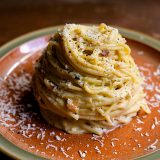Tucked into the backside of Piazza Trinita del Monti, its ancient stone doorway partly obscured by vines, Sora Magherita is unassuming, slightly hushed. Lucia Ziroli, who runs the 90-year-old trattoria with her husband and son, is anything but.
“É impossibile,” the 5-foot-tall wall of no says sternly over and again as I plead and flatter for an hour. I could not get a table. And I certainly could not get into the restaurant's tiny, crowded kitchen.
Sora Magherita is the sort of place where tender, eggy pasta is made fresh each morning, hung to dry over the backs of chairs. Where the menu is handwritten and rarely used. Where the wine is house, served in carafes on wobbly tables.
It also serves one of Rome's best plates of cacio e pepe—literally cheese and pepper—the city's most iconic pasta. Three ingredients—pasta, pecorino Romano and copious black pepper—it is a study in the power of letting a few ingredients shine.
A table barely large enough for a wine glass and plate opens unexpectedly—tight to a wall papered with admiring notes from patrons—and Ziroli relents. No order is needed. A carafe of wine appears unbidden. Then the cacio e pepe.
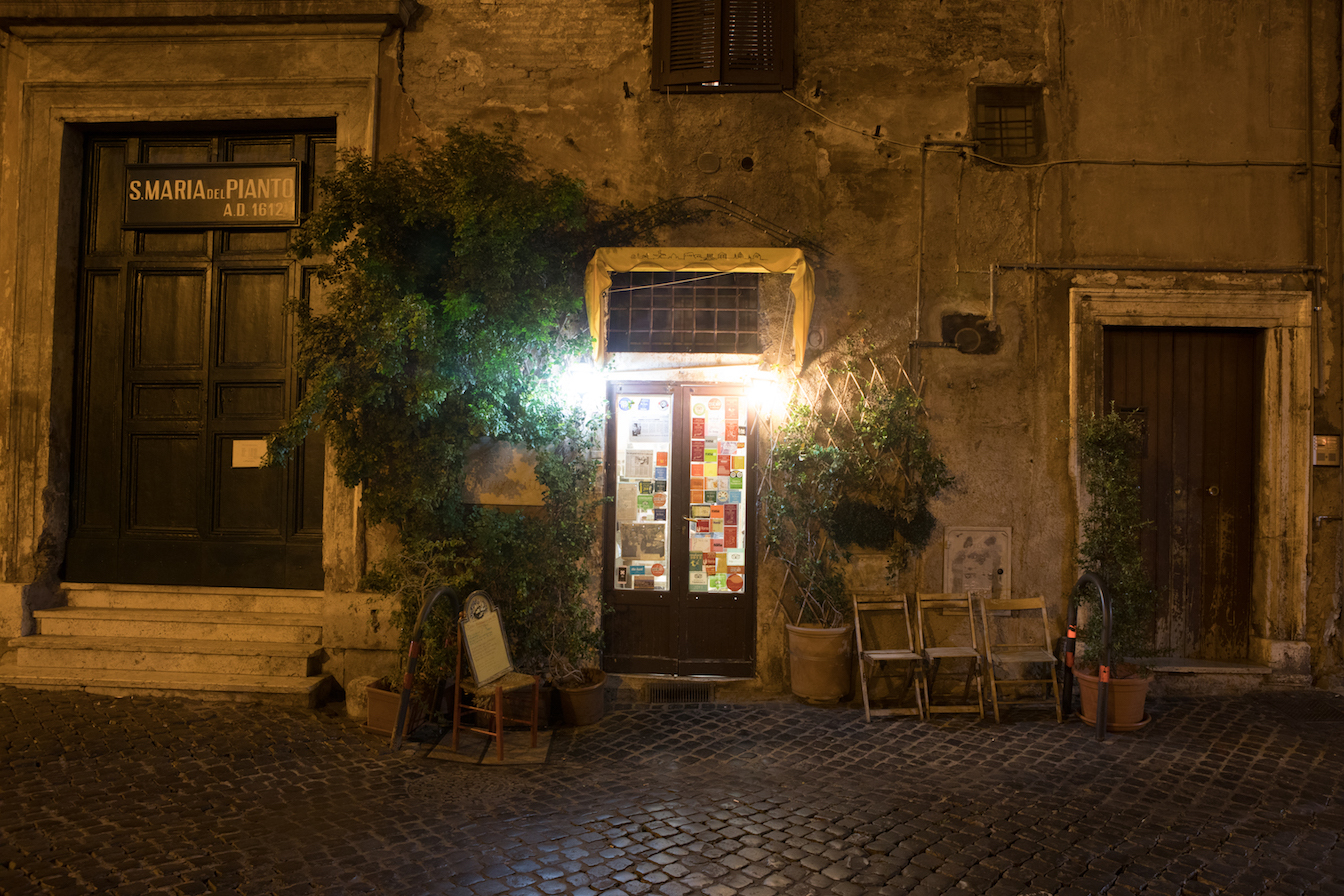
To call it transformative is insufficient. The pasta is pillowy, of course. But the miracle is the marriage—the effortless blending of cheese and pepper to form a smooth, punchy sauce that coated richly, yet without heft.
As my praise grows fevered, Ziroli softens. Soon I stand at the kitchen. Pecorino and pepper are mixed with starchy pasta cooking water. Then the noodles, and much tossing. More cheese and pepper. More tossing. It is done in seconds.
And it should be eaten almost as quickly, Ziroli admonishes, before the cheese cools and sets. Fingering strands of rough-cut, irregular noodles and popping them into her mouth, she tells me how she once took a plate of cacio e pepe away from a woman who was taking too long to eat it. “You need to eat it with gusto,” she explains. “Americans talk too much.”
American-Italian fare is robust, pungent with garlic, tomato and herbs. In Rome, a bold simplicity built from few ingredients is more common. You never know whether it was carefully executed or carelessly tossed together. The truth likely is yes.
I wouldn't learn just how deceptive—perhaps even impossible—that simplicity is until I got home and watched my own pasta, pecorino and pepper break into a clumped, ugly mess. But first, I needed to meet the rest of the family.
Rome is a riot of aromas, wafting from shops and sprawling markets where nuns bicker with fishmongers, and cured meats, red and marbled, are mounded in piles next to breads cut and sold to order by the gram.
Today, those aromas drift down a set of wide, worn marble stairs as I climb to Mario Ive's otherwise modern apartment on the outskirts of the city. “It's Sunday,” the retired army artillery colonel and author of a Roman cookbook says by way of welcome. “The old ladies are cooking.”
Ives agreed to be my guide to what most Romans consider a pasta matriarchy. It all begins with cacio e pepe. Though it's origins are debated—one popular theory is that cheese and black pepper were the only ingredients shepherds could carry into the mountains—it is widely accepted as the mother pasta.
To make the point, Ive prepares cacio e pepe, as refreshingly casual as Ziroli's. Then he makes it again, but this time crisping chopped guanciale—cured pork jowl—and mixing it and its fat into the dish at the end. Now it is gricia.
Then he prepares it a third time, still crisping the guanciale, but now mixing the pecorino and pepper with four egg yolks, a mixture he tosses with the cooking water, then the pasta and guanciale. He presents carbonara.
“It's like a tree. The main body is cacio e pepe,” Ive explains. “The branches are gricia and carbonara.”
The results are stunning. Cacio e pepe transformed, one basic dish going from salty-cheesy to savory-smoky to creamy-lush. Yet no iteration feels burdened. It's partly because the meat is an accent; Ive used a scant few ounces for four servings.
But mostly it's the pepper, which he measures by the teaspoon for every tablespoon of grated cheese. It lingers on the tongue with a pleasant heat. And that's when I begin to understand the appeal of this family of pasta dishes—balance.
In all three dishes, the pepper doesn't merely season or pretend to be salt's partner. It has a distinct role complementing and contrasting the heavier flavors. It hits me: These dishes have no acid, the traditional counterpoint to richness. The black pepper—so aggressively added—is playing that role, cutting through the cheese and pork.
“That's the secret of Roman cuisine,” Ive says. “We use very few ingredients and try not to let one of them take over.”
In the United States we use black pepper mindlessly, a plus-one to salt. But in Roman pastas, the pepper is added so copiously, it becomes a defining part of the dish. "As if it were raining pepper," one home cook explained.
Now with eggs!
Romans, it turns out, love a good pasta legend, the origins of carbonara a prime example.
Some say the dish was born after WWII, thanks in part to American soldiers and their packets of MRE eggs. Others say the name is drawn from “carbone,” or charcoal—a reference to the dish's complexion thanks to all that pepper.
Whatever its roots, I'm urged to try the carbonara at Pipero Roma, a whitest-of-white table cloth restaurant across from an imposingly baroque 1500s church, the Parrocchia Santa Maria in Vallicella.
My hopes are not high as I enter, flanked by a busload of Japanese tourists. But when the carbonara comes, it is unlike any I've ever eaten—too often heavy, densely cheesy and loaded with pork.
The sauce is light, airy even. And bright marigold yellow. The flavor is rich, yet fleeting. I desperately want to be uncouth and ask for bread to sop up the remains. Instead, I scrape the plate with my fork for every last smear.
In the kitchen, the difference becomes clear. Chef David Puleio has added an unorthodox ingredient—air.
He demonstrates the recipe, drawing on the same basic ingredients I've now seen so many times. Except, when he combines the cheese, pepper, egg yolks and pasta cooking water, he does so in a bowl set over the boiling pasta.
And then he whisks. And whisks. And whisks, pumping air into the gently cooked, boldly bright sauce. By the time he is done—tossing in the pasta and guanciale—the sauce is whipped and voluminous.
Cracking the cheese code
I returned to Milk Street confident in the simplicity of these dishes. I was wrong. Multiple batches of cacio e pepe produced grainy, gross clumps of partly melted cheese. Even when we controlled for factors we knew could cause clumping—including temperature—our results were only marginally better.
Which got us thinking that perhaps the problem was one of the ingredients. Common to all three pastas is the cheese—pecorino Romano, a high-salt, aged sheep's milk cheese. Hard cheeses such as this naturally clump when melted.
Why didn't it in Rome? We learned that the high salt content combined with the starch in the pasta cooking water stabilizes the cheese as it melts, preventing the proteins in the cheese from clumping. But American pecorino has less salt and more calcium, two factors that increase the chance of clumping.
Which suggested an easy fix—use imported cheese. We were wrong again. Though better, we still never got that effortlessly smooth sauce. More digging into the science of cheese revealed a likely cause—the longer cheese ages, the more likely it is to clump. And imported cheese is almost necessarily older than freshly purchased in Rome.
In true Roman fashion, the solution ended up being simple. We knew starch stabilizes melting cheese. For Italian cheeses, the starch contained in the pasta cooking water is plenty to handle the job. Here? Not so much. And nothing we did to draw additional starch from the pasta was sufficient.
Instead, we added starch—in the form of cornstarch—to the cheese and pepper mixture itself. The result? An instant and perfectly emulsified cheese sauce that was so stable it even could be reheated.
Pasta Twirling
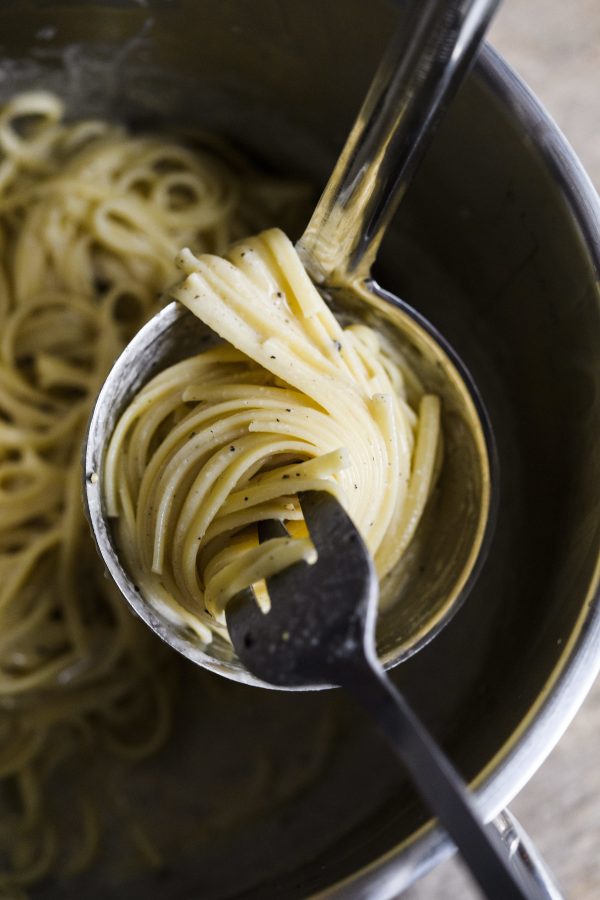
In Rome, pasta isn't piled—it's twirled into neat rounds. To serve, place a ladle into the pot of pasta.
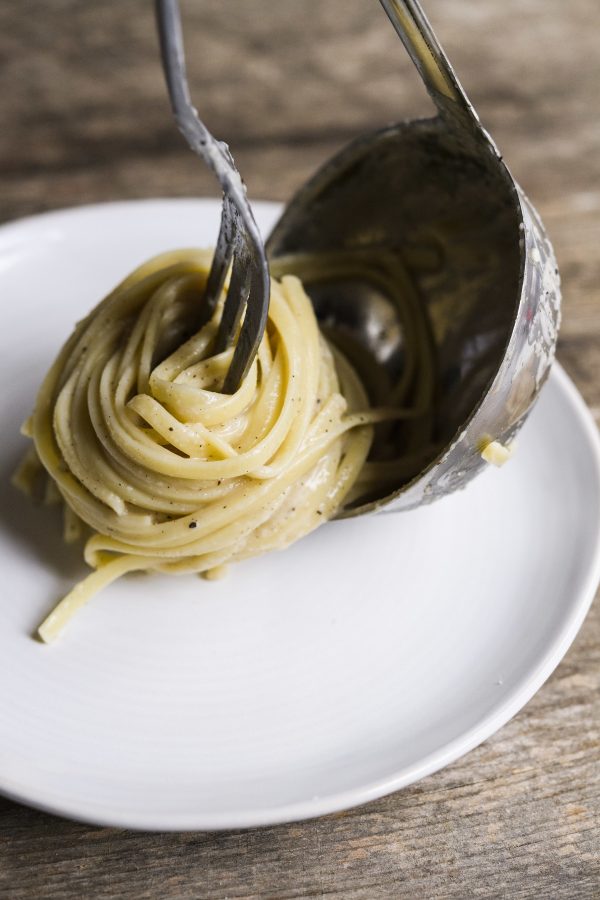
Then, use a long fork to gather and twist the pasta into a neat mound in the ladle.
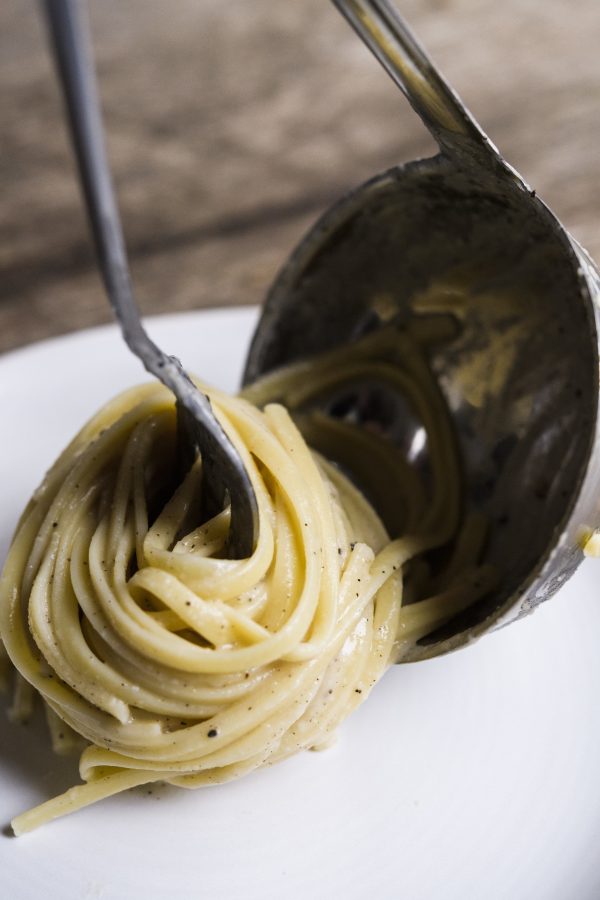
Slide the mound out onto a serving plate and lift out the fork.
